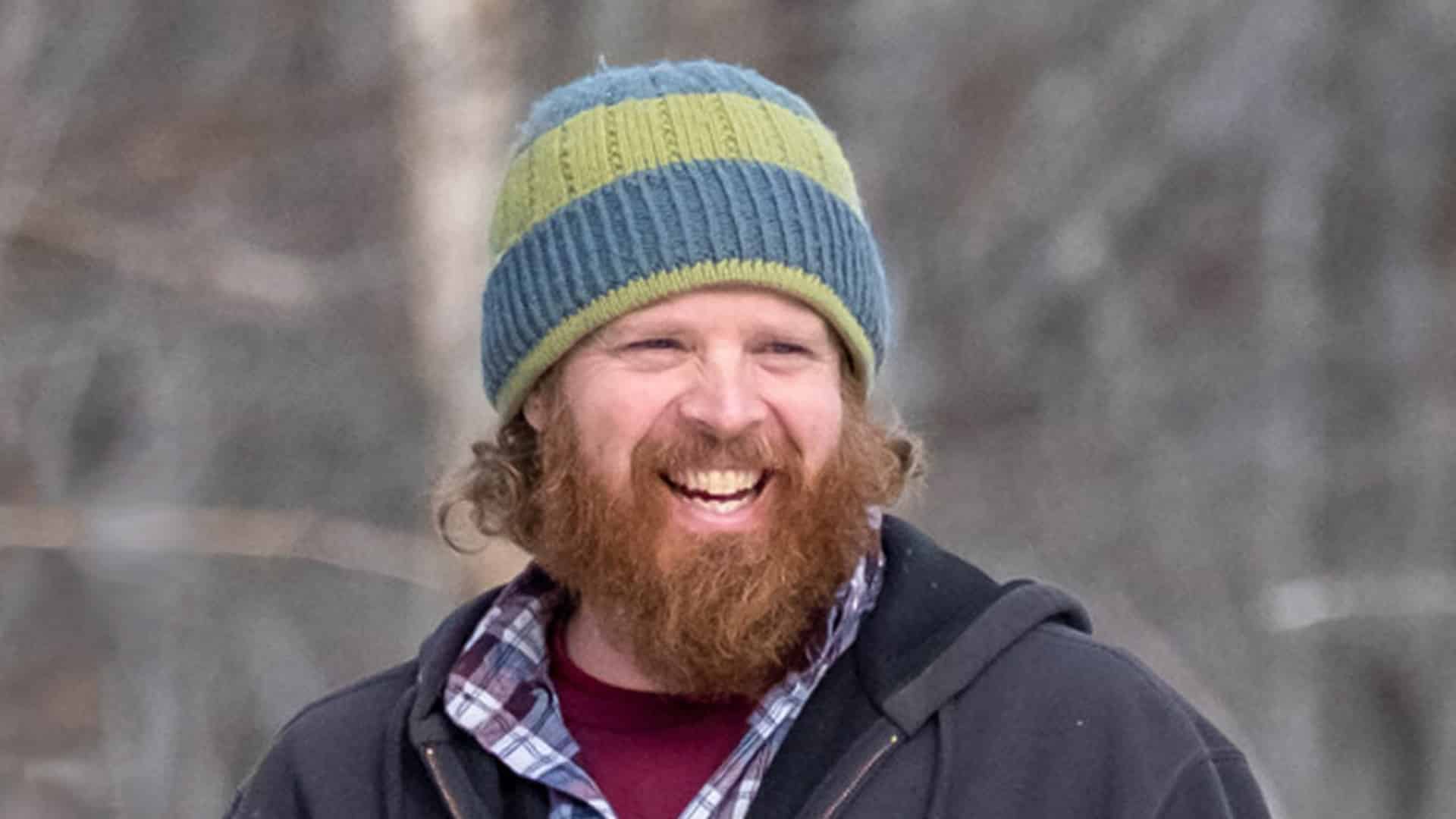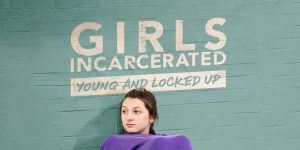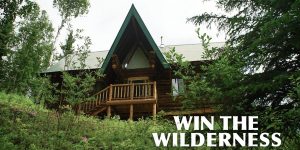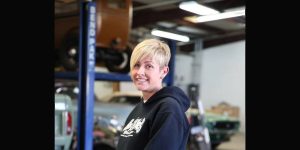Chase Morrill achieved celebrity status for his renovation work in “Maine Cabin Masters,” as this makeover-themed reality television series became number one on the ratings game on the DIY Network from when it premiered in 2017. Most found it amazing that the show sustained the interest of viewers over the years, and even after it found its new home on the Magnolia Network in 2022. He and his construction crew kept things real, and stayed true to their mission of preserving memories across their home state with the work that they did.
Get to know Chase Morrill
Chase, a 10th-generation Mainer, was born on 25 December 1977, and grew up in the Augusta-Gardiner area. His father, Eric Arthur Morrill, joined the US Army after high school and served overseas. He met his future wife, Margaret, who was nicknamed Peggy, in Germany. She was from Washington, and she and Eric fell for each other and traveled all over Europe on a motorcycle from 1969 to 1970; he went home with Peggy in tow. They only had the money for flights from England to Newfoundland, and so they hitchhiked their way across the island, went on a ferry ride, and then found their way to Nova Scotia until they reached Augusta. They were married in Pemaquid a week later, in August 1970.
Both attended the University of Maine at Farmington, from which Eric graduated in 1974. He worked in social services as well as house construction and renovation, before he succumbed to cancer in 2014 at the age of 67. Peggy was described as a Jill-of-all-trades who helped with the family business.

He’s into dumpster diving, repurposing
Chase’s interest in reusing materials was brought on by growing up with a father who instilled in him the value of salvaging. When he and his sister were little, their father would bring them along driving around Augusta during ‘pick-up week.’ When his dad saw something he thought was worth saving, he’d ask the kids to pick it up and throw it in the back of the truck. Chase also recalled having a hammer in his hand, as he followed his father around, who was very much into constructing furniture and creating metal sculptures.
Chase graduated from the College of the Atlantic with a Bachelor of Arts degree in Human Ecology with a focus on Chemistry and Asian Studies. During his college days, he was often seen by other students going through ‘trash.’ When looking at what other people consider garbage, Chase saw potential in them. For instance, he said, the old boards that someone pulled off from the exterior of a cabin, even if they were weathered and gray, still had life and could be used as an accent wall or to make furniture. He had a barn filled with all sorts of materials that he could use in future projects.
His family is his priority
He and his college sweetheart Sarah, who became his wife, had four children together: Maggie was the oldest daughter, Eleanor or Nori, Eva, and the youngest was their son Fletcher. The couple had been happily married for 17 years, and as Sarah greeted her husband on his birthday in 2022, she said, ‘Since our first travels together across North America to our latest travels across the world, life with you exceeds all expectations.’
His family was and would always be his number one priority. No matter how hectic and stressful things had become because of the schedule he kept through his business and the reality TV show, he made time for them. If he couldn’t come home, then his family would visit him while he was working. Having a supportive wife, cool kids, and a very understanding mom and mother-in-law made everything easier for him; as he said, ‘I could definitely not do it without them.’
He would have named his son Kermit if not for his mom
Sarah and Chase planned on naming their second child Kermit if he was a boy. He said that it was a good name – Theodore Roosevelt, the 26th US President, had a brother named Kermit. His mom, however, hated that name and so she bought a puppy and named it Kermit without telling them, so that they couldn’t use that name on their child. Later on, when his kids heard this story, his daughter Eva wrote her grandmother a letter thanking her because they disliked that name too for their sibling, as they associated it with Kermit, the frog.
“Maine Cabin Masters”
The reality TV show featured Chase, his sister Ashley and her husband Ryan Eldridge along with their friends Lance, Jedi, and Dixie growing up, as they fixed and renovated dilapidated cabins or camps across their home state. He was the boss and team leader, while Ashley was in charge of the design. He described his brother-in-law as the voice of reason. Even if what they were doing was kind of the same in each episode, from meeting a camp owner to the big reveal at the end, each cabin was unique, as it had a different story to tell. Most contractors would just tear down these run-down cabins and construct new ones, but for team Morrill, they wanted to preserve the family history in these places.
How did it come about?
With the rugged beauty of Maine – its vast wilderness as well as the coves, estuaries, rocky promontories and peninsulas along the coastline, it was no wonder that a production company called Dorsey Pictures out of Denver, Colorado was interested in making it as the backdrop of a reality show they were conceptualizing. When Chase Morrill heard about it from the mother of his daughter’s best friend, he reached out to the production via e-mail, and after a series of Skype interviews, they came to an agreement.
It couldn’t have come at a better time, as Chase along with his brother-in-law Ryan, Jedi and Dixie was constructing a timber frame in Wayne, so when the production team came, they could immediately film how the guys worked. He recalled that seven black SUVs showed up at the job site with the crew dressed in all black as they set up their cameras, lighting, and sound gear.
https://www.facebook.com/watch/?v=198973415325069
From the get-go, the producers warned them not to get their hopes up, because only one pilot in a thousand would get picked up, but that was fine with Chase’s team, as he said that they had fun making it, and thought that it would be a cool story to tell someday. The network liked what they saw, and by November, the Mainers had signed a contract on the hood of Chase’s truck without reading it first, but fortunately for them, everything worked out just fine. Late, Chase jokingly said that what helped seal the deal was their accents and the beards – the guys all had them.
How authentic was the show?
Reality shows were often suspected of being scripted, because fans felt that some of the storylines seemed too far-fetched. Chase cleared things up in an interview, saying that they didn’t follow a script when they were filming. Everything they said, every reaction was spontaneous. They were mic’d up, and as they went about doing their job, it was easy to forget that they were being recorded, and so didn’t filter the things they said. It was then up to the production to pick what they would use.
During the time when the show was still being formed, they were being coached during confessionals to make their commentary more cohesive or comprehensible, at least until Chase’s team got the hang of it. The production also kept stopping the work as they were asked to act out a certain scenario, but it wasn’t working because it appeared too manufactured, so they scrapped that. At first, Chase couldn’t understand the filming or production process. ‘Once we finally saw an episode, we’re like ‘oh, this makes sense’, you know, they film from the back, they film from the front it has to look the same.’ He appreciated how the production made them and what they did look good, and appealing to viewers.
Choosing cabins for the series
In season one, finding cabins that they could feature in the reality series was a tad difficult because it entailed a lot of trust on the part of the owner to hand over the keys to Chase and the production and then let them film the renovation process that would take around eight to 12 weeks. They had to borrow and beg for cabins at first, but once the show reached a certain level of popularity, and people had seen how they worked and how they transformed the cabins, they were inundated with requests to fix camps all over the state, and even beyond.
Since it was for TV, it was important to select cabins that not only had a great story attached to them, but that once the transformation was complete, there should also be a significant change to the overall look – it couldn’t be just a matter of replacing rotted wood that wouldn’t be visible to the audience.
Pilot episode – the Daggett’s 1936 camp
The team worked together to save the Daggett camp, as it was pretty rotten, certainly unlivable. It had been in Tom Daggett’s family for 60 years, and they had never once thought of tearing down the whole place, because it was important for him to preserve the memories his family had in this camp. The budget for it was $30,000, and it had to be done in six weeks’ time. After the walk-through, Chase had pretty much envisioned how the place would look, keeping in mind what the owners wanted.
.@DIYNetwork show, @mainecabinmstrs, transforms local camps https://t.co/D9eKMLkedv #MaineCabinMasters pic.twitter.com/LRDMkhOjZ0
— Sun Journal 🗞 (@sunjournal) April 17, 2018
They did demolition work during the first week, and as each succeeding week passed showing how their work was progressing, viewers could also see how the crew enjoyed working together. Chase said, ‘We’re out here working on these camps in the middle of winter. If we can’t have fun, why do it? If we love what we’re doing…we’ll keep doing it.’
Ashley worked on making signature pieces using materials they salvaged from the camp, such as turning an old canoe into a bookcase ,and using paddles as blades of a ceiling fan. The owners were quite overwhelmed with how everything turned out, from the facade to the interior. Seeing a rundown camp transformed into something beautiful was great, and one could easily understand why the show gained a loyal following.
Brought comfort to viewers during the pandemic
Viewers were grateful that they got to enjoy Maine through the show, and it became a form of escape for them particularly, during the pandemic, as they were trapped inside their homes due to lockdowns at that time. Chase said that, unlike other productions that shut down, they were fortunate in that they continued filming because they were isolated enough, and they limited the number of people on the site. During the big reveal, they only had one cameraman to get everything set up. Chase and Ashley did a walk-through of the cabin before leaving the keys, and then the owners came to check out the newly renovated place.
Being a celebrity
Being part of a hit TV show made Chase one of the most recognizable faces in America. When he was asked during an interview if being a reality star had changed him or the way he acted in public, he replied that he didn’t think so, saying that while he was treated like a celebrity outside of his home, as people wanted to take a photo with him or asked for his autograph, he said that having four teenagers kept things real for him, and kept him grounded.
Family dynamics
The potential for conflict was quite high, when one was in the same company as a family member, but there was never an issue or problem between Chase and his sister and her husband. They worked well together, and this was probably why their business and show were successful. They inspired and challenged each other, and fans said it was fun to watch. He disclosed that they had little fights and arguments, but they talked things through, and usually forgot what it was all about an hour or two later.
The working environment was so good that Chase was confident in bringing his wife and kids along to the site whenever possible. They often came to the camp, as they brought hot meals for the guys, and made themselves right at home.
Kennebec Cabin Company
Chase along with Ryan and Ashley established the Kennebec Cabin Company to continue the work they started in the reality TV series, since they knew that it would end someday. Their headquarters was located in Manchester, Maine, and they had a space for a retail store, recording studio, Ashley’s office, conference room, and more.
The company was described as the home of “Maine Cabin Masters,” and they used it to connect with their fan base. Their retail store offered a little bit of everything that one would want to have in their camps, whether it was essential or for aesthetic purposes as well as merchandise for fans. They featured the work of the craftsmen and artists that Ashley discovered through the show.
From their studio, Chase and Ryan hosted a podcast called “From the Woodshed”, and their producer was Chase’s daughter Maggie. It’s available on Spotify and iTunes, but fans could also watch them on their YouTube Channel. They interviewed various personalities and talked about life in Maine, renovation work, and behind-the-scenes of the reality series. Five years into the show, the two decided to do this podcast as a ‘side gig.’
Also incorporated into their headquarters was a bar, restaurant, and events venue they called The Woodshed. They served sandwiches, soups, and microbrews on draft to families and friends, who hung out to have some fun listening to live music on the outdoor patio.
On money matters
Viewers wondered about the budget for the cabin projects, as they felt that the amount was ridiculously low. The price that was flashed on the screen was the actual budget of the camp owner; it was the amount they paid, and this was essentially the money used to buy the materials, usually at a discounted rate because it was a great way to promote the products. Some were even salvaged from other camps. Although the interior was designed for TV and needed the ‘Wow!’ factor, as much as possible, they tried to keep it under budget, so that the owners could keep everything, including furniture.
https://www.instagram.com/p/Ckq57f7rwsx/
Chase’s company didn’t make a profit from the work they did on the camps that were featured on the show. They didn’t charge their clients for labor, because they were paid by the production company for doing the TV series. Reportedly, Chase’s salary per episode was around $30,000. His estimated net worth as of March 2023, according to authoritative sources, is $600,000.
Grateful for what they achieved because of the show, they liked to give back to the community, and so they took part in various projects such as constructing a playground for YMCA or upgrading a facility for wounded warriors to make it more accessible to those with handicaps. Chase wanted to ensure that they contributed to making life better for a lot of people.










Leave a Comment